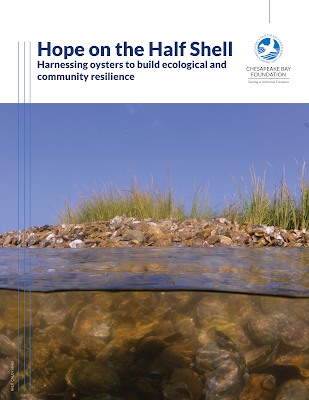Hope on the Half Shell - Harnessing oysters to build ecological and community resilience (PDF) is the latest documentation of how well oysters protect myriad elements of the Chesapeake Bay. The report also explains the ways that we have degraded oyster habitat through practice and policy as well as identifying policy and practice changes that will allow oysters and the environment more broadly to flourish.
Some of the changes recommended are:
- Restore and protect oysters’ three-dimensional reef habitat to enhance productivity of commercial and recreational fisheries. (Equitable economic opportunities for coastal communities)
- Expand equitable opportunities in oyster aquaculture by: increasing access to public waterfront; providing support and funding for capital investments; investing in hatchery infrastructure; prioritizing workforce development; and implementing and supporting programs that provide technical support for entry into the industry. (Equitable economic opportunities for coastal communities)
- Pursue policies that make room for habitat migration to adapt with changing conditions. (Increased resilience to sea-level rise and storm surge)
- Incorporate landscape- and population-scale approaches to restoration strategies and projects to maximize sustainability and the mutual benefits of complex habitats, such as oysters, living shorelines, and SAV. (Climate change mitigation)
- Fully utilize the most up-to-date scientific information and methods to manage oysters, including: initiating an oyster stock assessment in Virginia; implementing harvest quotas; considering spatial variables in management; and electronic harvest reporting. (Modernized fishery management for sustainable harvests)
- Re-center science and improve transparency in decision-making—including better accounting and data-sharing. (Transparency and accountability in fishery management)
- Improve navigability and usability of websites and event calendars to ensure full access to public meetings and hearings. (Transparency and accountability in fishery management)
WHRO’s article “Hope on the Half Shell:” Report says oysters can fight climate change in the Chesapeake Bay summarizes the CBF report and pulls in other important docs and reports, Virginia oyster harvest hits milestone and Chesapeake Bay cleanup is taking much longer than expected — and needs to switch gears, new research says, for example.
The improvements are essential to provide adequate environments for oyster growing and to keep the Virginia oyster business thriving. Virginia is on a roll: “Virginia watermen and oyster eaters in the 2022-2023 season enjoyed the strongest harvest in 35 years, at more than 700,000 bushels.” (Source: Virginia is East Coast’s Top Oyster Producer) And Anna Spiegel writes in Maryland and Virginia are in the midst of an oyster boom, “Virginia's seafood industry contributes more than $1.1 billion to the state's economy, according to recent figures from the Virginia Seafood Agricultural Research and Extension Center.”
